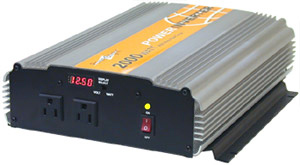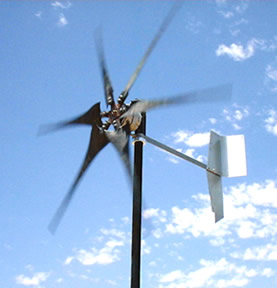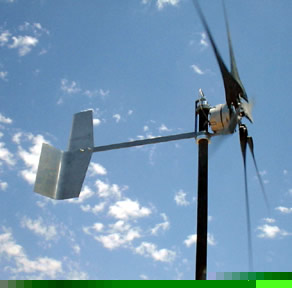![]() email me - warrens@ns.sympatico.ca.
email me - warrens@ns.sympatico.ca.
Last changed 23 October 2005
I'm putting the project on hold for the winter and will resume tower construction in the spring. The municipal council says I need to have all construction drawings approved and stamped by an engineer before a building permit will be issued. I know (and work with) engineers who don't have the common sense to properly install a ladder, let alone understand what I'm building. While I'm entirely confidant in my design, I need to find someone I feel is competant enough to look things over. Over winter I'll have the opportunity to build the aluminum guy wire brackets, complete the drawings, and find someone who understands tower structures and electrical requirements adequately to sign the design. I'll have things ready to go when the snow has gone. If needed, the batteries and inverters can still be used as a large UPS to power things for a couple of days, and my gas generator can top of the charge whenever it is running.
I am in the process of installing a wind generating system. Wind power will supplement commercial power feeding the house. I am not under any illusion of free power forever, nor being able to power everything in the house. It's a project for experimenting and learning. I enjoy projects where I can research an idea, design a system, and put it all together. This combines my interest, knowledge, and abilities in tower construction, electrical and electronics systems. Not knowing the precise math and minimum design requirements for tower construction I prefer to build to overbuild and not worry about things later. Friends in the tower business have looked over my construction as things proceed. So far the comments indicate overkill to the point of being silly. Having the system built this way will allow a larger generator to be mounted or possibly a larger tower to be built later. It will provide hands on experience and useful energy. If it works as hoped I'll be happy to help others with similar installations. Pictures will be added as the project progresses.
The first step in any project such as this is to analyze electrical use and reduce consumption. Most of the light bulbs in the house have been replaced with compact florescent lights. Programmable thermostats automatically reduce temperature at night and save money both on furnace oil and electricity. Extra zones provide extra temperature control to ensure no room is neither too hot nor too cold. New appliances were purchased when we moved into the house.
Once installed, wind power is free, non poluting, and essentially endless energy. With concern over green house gasses and other pollution, this is just one small step towards a greener environment.
Equipment for this type project can be very expensive. Be prepared for sticker shock once you go shopping.

 Click image to enlarge.
Click image to enlarge.
I've installed four 12VDC batteries in a used equipment rack. The inverters are shelf mounted with a 28VDC 20A power supply which will act as a charger while I'm running my backup generator during a power outage or monthly tests. The aluminum box on the left side of the rack above the inverters holds the six isolating diodes. The load diversion resistors will mount in the top 14 inches of the rack. The six blades for the propeller are laying on top of the rack. Here is a wiring diagram to show how everything is connected.
The turbine will mount on an 80 foot guyed aluminum tower. The tower will easily handle a much larger wind generator in the future if the system proves feasible. If you are planning to build a wind turbine, get it as high as possible. Don't waste time with something simply 30 feet off the ground if there are trees around. It must be well above any obstacles from all directions in order to get clean strong air. Having a wind turbine near the ground is comparable to putting solar PV panels in the shade.
I've drawn some diagrams for the tower installation.
Tower layout,
Tower brackets for guy wires,
Guy cable assemblies,
Tower profile,
Tower base plate,
Center foundation and support shaft.
This type of wind system is relatively simple in operation.
It is essentially a battery charger with 120VAC inverters. The generator or solar PV panels continually charge the batteries and the inverters use the stored energy as required to supply electrical energy to the house.
The generator is essentially a remanufactured automotive alternator. The field windings have been replaced by permanent magnets. Higher wind will spin the generator faster, creating higher voltage and power. There is no voltage regulation supplied.
Large wires will carry current inside the house to charge a large battery bank. Four 12V batteries will be connected as a 24V system. They will store energy until needed.
I will be using a pair of 24V DC battery banks. I chose 24V over 12V to reduce current requirements and get higher efficiency throughout the system.
A pair of inverters will change the battery output into 120VAC to power items in the house.
Only during periods when I have to run the gasoline generator will the battery charger be turned on to ensure the batteries are fully charged.
I'm open to any ideas or suggestions from those who have experience in this area. I welcome any input for improvements, good links, and so on. Please get in touch if you have anything to add.
I'm looking for extra batteries to enlarge the storage capacity of the system. Very large deep cycle batteries such as used by the phone company or in fork lift trucks could be ideal. These weigh on the order of 100 pounds or more each. Standard automotive starting type batteries are not suitable. If you know where I can get a set at a reasonable price I'd be interested.
| 1971 - 2000 wind speed for Halifax, from Environment Canada | Jan | Feb | Mar | Apr | May | Jun | Jul | Aug | Sep | Oct | Nov | Dec | Avg |
| Speed (km/h) | 18.6 | 18.4 | 19.0 | 18.6 | 16.7 | 15.6 | 14.5 | 13.5 | 14.6 | 16.1 | 17.6 | 18.4 | 16.8 |
| Direction | W | W | W | S | S | S | S | S | S | S | NW | W | S |
Based on these numbers, I'm expecting an average power output of about 80 watts, almost 2kWh of energy each day. This is about what is required for the fridge and furnace. If there is extra capacity I may connect other items such as the freezer, and possibly some lighting. Unfortunately when the house was originally wired, lighting and electrical outlets were on common circuits. Connecting to the inverter would prevent use of a hair dryer or other high power devices due to a very high demand on the batteries. A higher power wind generator or addition of photovoltaic cells would also allow connection of more items.
Environment Canada data is based upon measurements taken at 30 feet above ground. Getting the generator 80 feet in the air should place it into an area of less turbulent and higher speed air. Power output will increase considerably if this is the case.


I will be using a PowerBright AED2000-24 modified sine wave inverter rated 2kW continuous, 4kW surge output power, as well as a ProSine 1000 true sine wave inverter rated 1kW continuous, 1.5kW surge.

 Manufacturer pictures, not mine.
Manufacturer pictures, not mine.
A Hornet HT3M will generate power from the wind. This is a 800W turbine meant for operation in a 48VDC system. It has a diameter of 1.5 meters. After looking at wind data for Halifax, the HT2M will likely not supply enough voltage to charge the batteries. Average yearly windspeed for Halifax is only 16.8km/h or about 10mph. Looking at the output voltage curves for both turbines, the best option seems to be the 48V model. Some excess voltage will be used for battery charging, and the rest dumped to a heat load.
The pictures show an unpainted Hornet turbine. I plan to paint one of the blades yellow and leave the others black. It will help to see how fast the blades are turning.
This is a quotation from an owner in Virginia,
Hornet wind turbine testimonial.
It is a very quiet turbine, a barely audible whispering hiss could be heard while standing at the base of the mast and had no detectable vibration of any kind.
This is a very neighbor friendly wind turbine, its near silent operation makes it unobtrusive, I painted the blade tips yellow, as is the body, hub and tail, making it resemble a giant sunflower. Considering zoning limits, I classify it as a lawn ornament. My concerns of neighbor complaints were needless, all of them frequently stop by, look and marvel, waiting for a breeze to start it turning and ask endless questions about it.
I've designed a simple automatic dump load circuit. Any excess energy will be used for heating my attached garage. As such, a PWM controller is not needed. A bank of high power resistors and transistors will turn on to maintain a maximum battery voltage. If excess energy was to be used for heating water or another area of the house, a PWM controller could be beneficial. I'll cross that bridge when the time comes.
A hand drawn circuit and description is available here.
I will not be purchasing a commercial charge controller. None are really meant for wind generator operation, and simply act as dump load regulators. I hope to justify the system by having it pay for itself in electrical savings. Fancy controllers and monitoring equipment may look pretty, but in reality are not needed for this application. Keeping the system simple and straightforward should allow maximum overall efficiency and keep the cost lower. When solar PV panels are added, a MPPT controller will assist to maximize power supplied.
The inverters will automatically shut down when the batteries discharge to 22V. When this happens, the AC transfer relays will deenergize, and all loads will switch back to to commercial power. The wind turbine will be able to charge the battery bank. When the batteries have been sufficiently charged the AC inverter will be turned on again, energizing the relays and returning load to wind generated power.
I have a Kill A Watt power monitor to measure the amount of energy required by my home. It will will display everything from current requirements to kilowatt hour consumption for whatever is plugged into it. Cost is about $50 Canadian. It does not work with a modified sine wave inverter, but is very useful for preliminary calculations and measurements when planning.
20 September. Excavation pictures. Click to enlarge.





26 September. Guy anchors and center base.


 24 June 2005
24 June 2005
Finally some progress to show... It's been a busy winter, and with record rain fall during spring I was unable to get much outdoor work done at all. The project is way behind schedule.
This is the center foundation post. The tower base will rest on top of the post which will be set in concrete.
 This is the tower base. It is upside down and needs a ring welded to the center. The post will fit inside the ring, holding the base steady. The post to base joint is not welded and will allow the tower to flex or move as required. The tower will bolt to the base with plastic spacers separating the aluminum from the steel to prevent corrosion.
This is the tower base. It is upside down and needs a ring welded to the center. The post will fit inside the ring, holding the base steady. The post to base joint is not welded and will allow the tower to flex or move as required. The tower will bolt to the base with plastic spacers separating the aluminum from the steel to prevent corrosion.

 I've used a portable mixer to fill about 6 inches of the center hole. This provides a solid footing for the center post instead of having it resting on soil at the bottom. The center post is in position. There is a pump in the hole to empty as much water as possible before pouring concrete. Some extra bracing is needed around the form to prevent it from bulging and bursting once filled.
I've used a portable mixer to fill about 6 inches of the center hole. This provides a solid footing for the center post instead of having it resting on soil at the bottom. The center post is in position. There is a pump in the hole to empty as much water as possible before pouring concrete. Some extra bracing is needed around the form to prevent it from bulging and bursting once filled.


 24 July 2005
24 July 2005
Anchor point 1
The anchors are greatly oversized for what I am building. Each anchor has a volume of over 1 cubic yard. A cubic yard of concrete weighs approximately 4050 pounds. They will be covered under about six inches of soil.
Anchor dimensions 72 x 29 x 30 inches = 1.34 cubic yards = 5430 pounds





 Anchor point 2
Anchor point 2
Dimensions 57 x 36 x 33 inches = 1.45 cubic yards = 5870 pounds





 Anchor point 3
Anchor point 3
Dimensions 54 x 34 x 32 inches = 1.26 cubic yards = 5100 pounds



 Tower center foundation
Tower center foundation
All tower weight will rest on the shaft and be free to move as required. The shaft rests on a six inch layer of reinforced concrete at the bottom and will be set in 1 cubic yard of concrete.
Dimensions 34 x 34 x 40 inches = 0.99 cubic yards = 4010 pounds (not including 6 inch layer)

 Tower base plate (upside down)
Tower base plate (upside down)
I still need to weld a ring or small blocks to the smaller square plate in the center. This is where the pin will rest and hold the tower weight.



 This is where the tower sections join. Four 3/8 inch bolts hold each corner together in a four inch overlap. I'll be using 1/4 inch thick aluminum to build guy attachments at each joint. If you recognize this tower and know the manufacturer it would be very useful information. Please let me know!
This is where the tower sections join. Four 3/8 inch bolts hold each corner together in a four inch overlap. I'll be using 1/4 inch thick aluminum to build guy attachments at each joint. If you recognize this tower and know the manufacturer it would be very useful information. Please let me know!



 10 August 2005.Pictures of the concrete pour. Chris and Gordon helped with the wheelbarrows when the truck became stuck. Three of four holes had to be filled this way. Eventually a second truck arrived to pull the first one out of the mud. There is a hoisting hook placed in the concrete of the tower base at the center. This will be used later for assembling the tower and raising the wind generator.
10 August 2005.Pictures of the concrete pour. Chris and Gordon helped with the wheelbarrows when the truck became stuck. Three of four holes had to be filled this way. Eventually a second truck arrived to pull the first one out of the mud. There is a hoisting hook placed in the concrete of the tower base at the center. This will be used later for assembling the tower and raising the wind generator.



 The project has come to yet another screaming halt. As of 15 August, my employer has locked out 5500 employees. There are higher priorities than tower construction at the moment (food, bills, gasoline, etc). Until a steady income resumes the concrete will continue to cure.
The project has come to yet another screaming halt. As of 15 August, my employer has locked out 5500 employees. There are higher priorities than tower construction at the moment (food, bills, gasoline, etc). Until a steady income resumes the concrete will continue to cure.
General Rules of Thumb
The power in the wind is proportional to the cube of the wind speed.
New Power = Original Power x (new windspeed)^3 / (original windspeed)^3
A doubling of wind speed will increase power by a factor of 8.
The power in the wind is proportional to the area swept by the rotor.
New Power = Original Power x (new diameter)^2 / (original diameter)^2
Doubling turbine diameter will increase potential output by a factor of 4.
Some other web sites.
Renewable and Electical Energy. Publications and information from Natural Resources Canada.
Sustainable Technology Ltd Danish Wind Industry AssociationCanadian Wind Energy Association
www.realgoods.com/ Alternative Energy periodical AE discussion board Solar Nova Scotia Bergey Wind Power Why Wind Power? Wind Power Battery Life Saver - desulfate - recondition - revive - deep cycle — restore car, auto, forklift, any 6, 12, 24, 36, 48 volt battery to like new condition
Email me - warrens@ns.sympatico.ca with any questions or comments.
Those who say something can not be done should not stand in the way of those who are doing it.